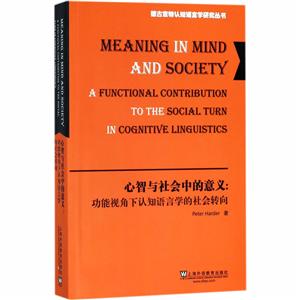包郵 心智與社會(huì)中的意義 功能視角下認(rèn)知語(yǔ)言學(xué)的社會(huì)轉(zhuǎn)向
-
>
考研英語(yǔ)背單詞20個(gè)詞根詞綴
-
>
西班牙語(yǔ)詞根寶典
-
>
美國(guó)K-12原版語(yǔ)文課本--初中·下(全12冊(cè))
-
>
流浪地球劉慈欣
-
>
西南聯(lián)大英文課 輕讀禮盒版
-
>
英語(yǔ)大書(shū)蟲(chóng)世界經(jīng)典名譯典藏書(shū)系:中國(guó)人的精神 (英漢對(duì)照)(精選權(quán)威版本)
-
>
許淵沖譯唐詩(shī)三百首:漢文·英語(yǔ)
心智與社會(huì)中的意義 功能視角下認(rèn)知語(yǔ)言學(xué)的社會(huì)轉(zhuǎn)向 版權(quán)信息
- ISBN:9787544650373
- 條形碼:9787544650373 ; 978-7-5446-5037-3
- 裝幀:平裝
- 冊(cè)數(shù):暫無(wú)
- 重量:暫無(wú)
- 所屬分類(lèi):>
心智與社會(huì)中的意義 功能視角下認(rèn)知語(yǔ)言學(xué)的社會(huì)轉(zhuǎn)向 內(nèi)容簡(jiǎn)介
《心智與社會(huì)中的意義:功能視角下認(rèn)知語(yǔ)言學(xué)的社會(huì)轉(zhuǎn)向(英文版)/德古意特認(rèn)知語(yǔ)言學(xué)研究叢書(shū)》是德古意特認(rèn)知語(yǔ)言學(xué)應(yīng)用叢書(shū)中的一本。叢書(shū)從德古意特出版社遴選引進(jìn),從不同角度呈現(xiàn)了認(rèn)知語(yǔ)言學(xué)理論研究的前沿成果。《心智與社會(huì)中的意義:功能視角下認(rèn)知語(yǔ)言學(xué)的社會(huì)轉(zhuǎn)向(英文版)/德古意特認(rèn)知語(yǔ)言學(xué)研究叢書(shū)》探討了語(yǔ)言與心智、社會(huì)的關(guān)系,以及認(rèn)知語(yǔ)言學(xué)在這方面所面臨的挑戰(zhàn)等。《心智與社會(huì)中的意義:功能視角下認(rèn)知語(yǔ)言學(xué)的社會(huì)轉(zhuǎn)向(英文版)/德古意特認(rèn)知語(yǔ)言學(xué)研究叢書(shū)》供語(yǔ)言學(xué)領(lǐng)域的研究生、專(zhuān)業(yè)研究人員參考使用。
心智與社會(huì)中的意義 功能視角下認(rèn)知語(yǔ)言學(xué)的社會(huì)轉(zhuǎn)向 目錄
1. What this book tries to do
2. A summary of the argument
2.1. There is no such thing as 'conceptual frames'(But there's a whole social-cognitive world)
2.2. On-line vs. off-line features
2.3. Social cognitive linguistics vs. analysis in terms of 'discourses'.
2.4. Functional relations and adaptation
3. The progression of the book
Chapter 1. The heartland of Cognitive Linguistics
1. Introduction
2. Conceptualization and concepts
3. Frames, domains, and idealized cognitive models
4. Embodiment and image schemas. From conceptual to neural patterns
5. Figurative meaning
6. Linguistic meaning: Polysemy, ambiguity, and abstraction
7. Mental spaces
8. Cognitive linguistics and cognitive grammar
9. Final remarks
Chapter 2. From conceptual representations to sodal processes:
aspects of the ongoing social turn
1. Introduction
2. Cognitivism and conceptualization in the sociocultural sphere
3. Variation, lexical semantics and corpus linguistics
4. The developmental perspective: epigenesis, joint attention and cultural learning
5. Extended grounding: situational, intersubjective and cultural aspects
6. Language as a population of utterances: an evolutionary synthesis
7. Meaning construction
8. Final remarks
Chapter 3: Social constructions and discourses
1. Introduction
2. The social construction of reality
3. Power, habitus, marginalization and discourse:the French poststructuralists
4. The analytic practice: discourse(s) analysis
5. Discursive psychology
6. Systemic-Functional Linguistics
7. Socially based theories of meaning: overview and issues
Chapter 4. The foundations of a socio-cognitive synthesis:social reality as the context of cognition
1. Introduction
2. Social facts: objective and subjective, intrinsic and observer-relative properties
3. Niche construction
4. Individuals, collectives and the invisible hand
5. Functional relations
6. Mind in society: causal patterns and the individual
7. Summary: the socio-cognitive world
Chapter 5. Meaning and flow: the relation between usage and competency
1. Introduction
2. Meaning as process input
3. Presupposition and the directional nature
of linguistic meaning
4. The procedural nature of competencies
5. Usage, competency and meaning construction
6. Conceptual categories and the flow. Messy and precise semantic territories
7. Summary
Chapter 6. Structure, function and variation
1. Introduction: the social foundations of structure
2. Usage, structure and component units
3. Function-based structure i
3.1. Structured division of labour- and arbitrariness as a functionally motivated property
3.2. Slots and constructions: coercion as construction-internal functional pressure
3.3. Functional upgrading: the dynamic dimension of syntax
3.4. The interdependence of the top-down and bottom-up perspectives
4. Norms and variation
4.1. Introduction: the interdependence of structure and variation
4.2. Variation and the linguistic 'system'.
4.3. The role of norms
4.4. Norms and individual competency
4.5. The social dynamics of linguistic variation
4.6. Usage, structure and variation in an evolutionary framework: a discussion with Croft
5. Summary: function-based structure and langue in a social cognitive linguistics
Chapter 7. Meaning and social reality
1. Introduction
2. The growth and structure of social constructions
2.1. The bottom-up trajectory. From construals to social constructions
2.2. Acceptance and efficacy: the evolutionary dynamics of social construction
2.3. Habitus vs. conceptual models: do we really need mental representations?
2.4. The Platonic projection: concepts as part of the niche
3. The role of acceptance
3.1. Beliefs as social constructions: causal power and grounding
3.2. The interface between niche and flow in social construction(s)
3.3. Bullshit: function and factual grounding
3.4 Re-conceptualization and social reality
4. Discourses analysis and social cognitive linguistics
4.1. What precisely are Foucault-style discourses?
4.2. How can discourses be understood in terms of a social cognitive linguistics?
4.3. Where Foucault-style analysis belongs -and where it is inadequate
5. Meaning in 'hard' social science: the case of International Relations
5.1. The Copenhagen school of international relations (CIR)
5.2. The need to distinguish between the niche and the flow
5.3. Niche construction and the grounding of layered identity structure
5.4. CIR, agency and factual grounding
6. Individual conceptualization and the social constructor
7. Cognitively based critical analysis -
a comparative perspectivization
8. Summary: Conceptualization in society
Chapter 8. Multi-ethnic societies: discourses vs. social cognitive linguistics
1. Introduction
2. The ethnic other: an ultra-brief historical overview
3. Social construction and universal humanity
4. A social cognitive analysis of the distinction between 'us' and 'them'.
5. Where discourses fail: the decline and fall of the anti-racist discourse in Denmark
6. Strategies based on collaborative agency: platform building and niche (re)construction
7. Asymmetric communication and the pathological 'they': the niche for discourses
8. Final remarks: why critical analysis needs functional relations and collaborative agency
Chapter 9: Summary and perspectives
References
Index
- >
自卑與超越
- >
月亮虎
- >
【精裝繪本】畫(huà)給孩子的中國(guó)神話(huà)
- >
新文學(xué)天穹兩巨星--魯迅與胡適/紅燭學(xué)術(shù)叢書(shū)(紅燭學(xué)術(shù)叢書(shū))
- >
苦雨齋序跋文-周作人自編集
- >
朝聞道
- >
我與地壇
- >
有舍有得是人生















